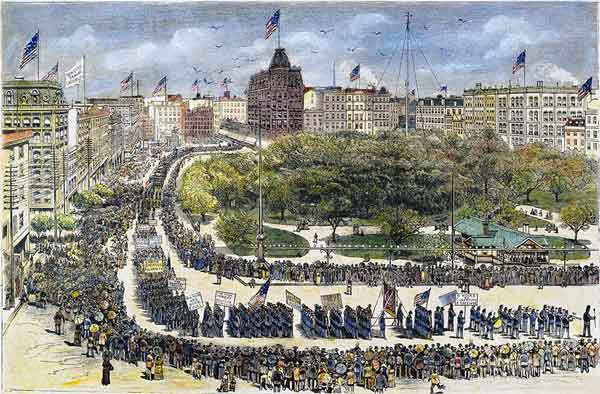On the morning of Sept. 5, 1882, a crowd of spectators filled the sidewalks of lower Manhattan near city hall and along Broadway. They had come early, well before the Labor Day Parade marchers, to claim the best vantage points from which to view the first Labor Day Parade.
A newspaper account of the day described “… men on horseback, men wearing regalia, men with society aprons, and men with flags, musical instruments, badges and all the other paraphernalia of a procession.”
The police, wary that a riot might break out, also were out in force that morning. By 9 a.m., columns of police and club-wielding officers on horseback surrounded city hall.
By 10 a.m., the grand marshal of the parade, William McCabe, his aides and their police escort were all in place for the start of the parade. There was only one problem: The few marchers who had shown up had no music, and none of the men had moved.
Spectators began to suggest that McCabe give up the idea of parading, but he was determined to start on time with the few marchers who had shown up. Suddenly, Mathew Maguire of the Central Labor Union of New York (and probably the father of Labor Day) ran across the lawn and told McCabe that 200 marchers from the Jewelers Union of Newark Two had just crossed the ferry — and they had a band!
Just after 10 a.m., the marching jewelers turned onto lower Broadway. They were playing “When I First Put This Uniform On,” from “Patience,” an opera by Gilbert and Sullivan.
The police escort then took its place in the street. McCabe and his aides stepped in behind the jewelers as they marched past. Then spectators joined the march. Eventually, 700 men were lined up in the first of three divisions of Labor Day marchers. Final reports of the total number of marchers ranged from 10,000 to 20,000 men and women.
With all of the pieces in place, the parade marched through lower Manhattan. The New York Tribune reported that, “The windows and roofs and even the lamp posts and awning frames were occupied by persons anxious to get a good view of the first parade in New York of workingmen of all trades united in one organization.”
At noon, the marchers arrived at Reservoir Park, the termination point of the parade. While some returned to work, most continued on to the post-parade party at Wendel’s Elm Park at 92nd Street and Ninth Avenue. Some unions that had not participated in the parade even showed up to join in the post-parade festivities, which included speeches, a picnic, an abundance of cigars and “lager beer kegs … mounted in every conceivable place.”
Until 9 p.m. that night, nearly 25,000 union members and their families filled the park in celebration of the very first Labor Day.
Information obtained from U.S. Department of Labor website, www.dol.gov.
Send questions/comments to the editors.



Success. Please wait for the page to reload. If the page does not reload within 5 seconds, please refresh the page.
Enter your email and password to access comments.
Hi, to comment on stories you must . This profile is in addition to your subscription and website login.
Already have a commenting profile? .
Invalid username/password.
Please check your email to confirm and complete your registration.
Only subscribers are eligible to post comments. Please subscribe or login first for digital access. Here’s why.
Use the form below to reset your password. When you've submitted your account email, we will send an email with a reset code.